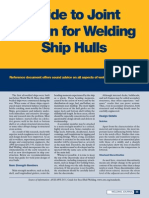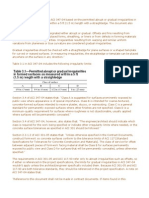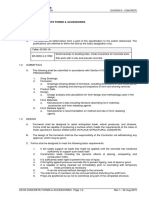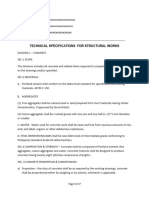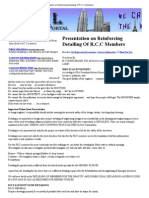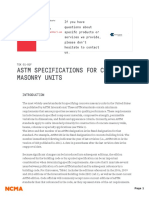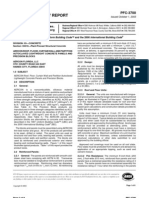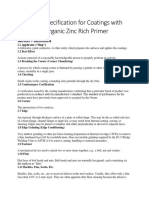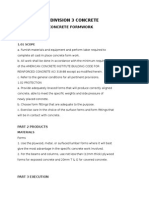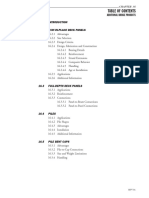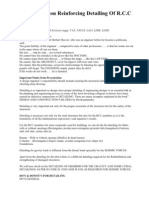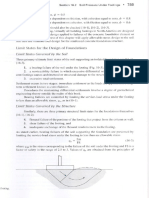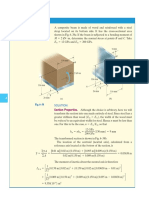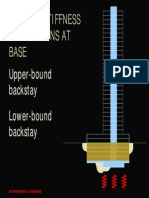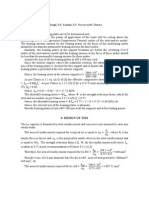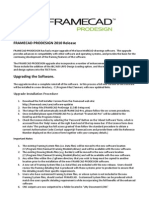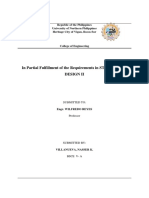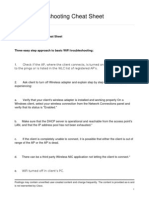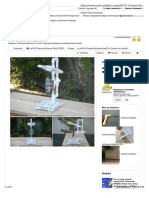Tolerances: Table 2 Surface Finish Class
Tolerances: Table 2 Surface Finish Class
Uploaded by
Humberto EstevezCopyright:
Available Formats
Tolerances: Table 2 Surface Finish Class
Tolerances: Table 2 Surface Finish Class
Uploaded by
Humberto EstevezOriginal Description:
Original Title
Copyright
Available Formats
Share this document
Did you find this document useful?
Is this content inappropriate?
Copyright:
Available Formats
Tolerances: Table 2 Surface Finish Class
Tolerances: Table 2 Surface Finish Class
Uploaded by
Humberto EstevezCopyright:
Available Formats
that all pans may require diaphragms to resist lateral
pressures. However, 14-gauge pans with a depth of
16 inches or greater should always be installed with
internal bracing. The soffits of all steel pans should
be strengthened with some type of permanently
attached internal brace, the most common of which
is a welded sheet metal angle at least of the same
gauge as the body of the pan. Because the steel lap
pan system is characterized by offsets, fins and
protrusions as well as chips and dings that result
from the removal of the pan sections, the contract
documents should include guidance and information
on acceptable tolerances for formed surfaces.
TOLERANCES
Tolerance guidance can be found in several ACI
standards and reports. ACI 117, Standard
Tolerances for Concrete Construction and Materials;
ACI 301, Specifications for Structural Concrete; and
ACI 347R, Guide to Formwork for Concrete, provide
information on finished surfaces, but do not address
pan joist surfaces specifically. ACI 117 and ACI
347R limit offsets and other irregularities based on
Class of surface finish. See Table 2. The ACI 117
standard might be regarded as the most
authoritative. The mandatory specification checklist
in ACI 117 requires the Architect/Engineer to
designate the intended Class of surface finish and
thereby establish the tolerance for form offsets. ACI
301 addresses the finishing of formed surfaces in
Chapter 2 and differentiates between rough form
finishes (those not exposed to public view) and
smooth finishes (exposed to public view). ACI 301
requires: Patch tie holes and defects. Remove all
fins completely. for smooth formed finishes, but
permits up to 1/4 inch fins for rough finishes. As a
default, Article 5.3.3.5 of ACI 301 calls for the finish
to be based on exposure to public view where
surface finish is not designated in the contract
documents.
TABLE 2
Type of
Irregularity
Figure 2
Lap Pan Shapes
Surface Finish Class
Class of Surface Finish
(Size of Permissible Defects in Inches)
A
B
C
D
Gradual
(ACI 347R)
1/8
1/4
1/2
Abrupt
(ACI 117)
(ACI 347R)
1/8
1/8
1/4
1/4
1/2
1/4
1
1
Class A: For surfaces prominently exposed to public view where
appearance is of special importance.
Class B: Coarse-textured concrete-formed surfaces intended to
receive plaster, stucco, or wainscoting.
Class C: General standard for permanently exposed surfaces where
other finishes are not specified.
Class D: Minimum-quality surface where roughness is not objectionable,
usually applied where surfaces will be concealed.
Figure 3
Setting Lap Pans
It should be pointed out that care must be taken
with the installation of any embedded items or
mechanical inserts or fixtures. If the attachment of
these items is not considered in relationship to the
stripping of these forms they may act as anchors
preventing the removal of the pan forms. Therefore, it
is recommended that only center pin soft rivets be
used. The center pin of the rivet will remain exposed
on the underside of the pan form and can be
removed prior to stripping. This will allow the body of
the rivet to close as the pan is stripped, permitting
the easy removal of the forms.
ACI Committee 347 notes that revisions of the
347R report are in progress to change the limit for
abrupt offsets within Class C finish to 1/2 inch,
consistent with ACI 117. Although ACI 347R cautions
against using pry bars directly against concrete to
remove formwork, this is common practice in many
areas of the country.
CONCLUSION
Surface irregularities should be expected in pan
joist construction. It is difficult to patch surface spalls
successfully. The patch may be more noticeable than
the spall. The continuing use of the steel lap pan joist
form system remains a proven and excellent method
of forming site cast reinforced concrete floor systems
in non-critically exposed applications.
You might also like
- AISE No. 7 Specifications For Ladle HooksDocument7 pagesAISE No. 7 Specifications For Ladle HookscadyfemNo ratings yet
- Certified Secure Web Application Engineer (CSWAE) Course Outline - Rev.2.1Document4 pagesCertified Secure Web Application Engineer (CSWAE) Course Outline - Rev.2.1Zidane LanceNo ratings yet
- Concrete Formwork SpecsDocument6 pagesConcrete Formwork Specsclive_2201100% (1)
- Guide To Joint Design For Welding Ship HullsDocument6 pagesGuide To Joint Design For Welding Ship HullspakzoNo ratings yet
- Reinforced Concrete Buildings: Behavior and DesignFrom EverandReinforced Concrete Buildings: Behavior and DesignRating: 5 out of 5 stars5/5 (1)
- Reinforced Concrete Grade Beams, Piles & Caissons: A Practical Guide for Hillside ConstructionFrom EverandReinforced Concrete Grade Beams, Piles & Caissons: A Practical Guide for Hillside ConstructionNo ratings yet
- Bs 1881-117 Concrete Dtermination of Tensile Splitting STRDocument12 pagesBs 1881-117 Concrete Dtermination of Tensile Splitting STRhajimak100% (1)
- Computer Shortcuts A To ZDocument9 pagesComputer Shortcuts A To ZMahesh KarpeNo ratings yet
- Ericsson eMBMS PDFDocument8 pagesEricsson eMBMS PDFAnonymous 23CEh9jUNo ratings yet
- SECTION 03 41 13 Precast Concrete Hollow Core Planks Spec Writer NoteDocument4 pagesSECTION 03 41 13 Precast Concrete Hollow Core Planks Spec Writer NoteJuanPaoloYbañezNo ratings yet
- Inspection and Maintenance of Steel Girders-12Document10 pagesInspection and Maintenance of Steel Girders-12vpmohammedNo ratings yet
- Presentation On Reinforcing Detailing of RCC MembersDocument20 pagesPresentation On Reinforcing Detailing of RCC MembersEhsan ShNo ratings yet
- Form WorkDocument3 pagesForm WorkNawzad Bilal HuseinNo ratings yet
- Pile Test and Concrete FaceDocument6 pagesPile Test and Concrete FaceEngineeri TadiyosNo ratings yet
- Section 03100-Concrete Forms and AccessoriesDocument4 pagesSection 03100-Concrete Forms and AccessoriesMØhãmmed ØwięsNo ratings yet
- Chapter M - Design of Fabrication and ErectionDocument5 pagesChapter M - Design of Fabrication and ErectionGirl Who LivedNo ratings yet
- AISE No7 Ladle Hooks 1991Document9 pagesAISE No7 Ladle Hooks 1991Zhifan FuNo ratings yet
- Rebar TolerancesDocument4 pagesRebar Tolerancesjade5704No ratings yet
- Design and Construction FailuresDocument23 pagesDesign and Construction Failuresgokulnath.asoorNo ratings yet
- Technical Specs - StructuralDocument7 pagesTechnical Specs - StructuralEvans CorpNo ratings yet
- 031100Document5 pages031100Janus AntonioNo ratings yet
- Appendix B CompuertaDocument2 pagesAppendix B CompuertaDantex IncaNo ratings yet
- Constructability of Embedded Steel Plates in CIP ConcreteDocument7 pagesConstructability of Embedded Steel Plates in CIP ConcreteimranNo ratings yet
- Presentation On Reinforcing Detailing of R.CDocument19 pagesPresentation On Reinforcing Detailing of R.CMC LeongNo ratings yet
- Astm Specifications For Concrete Masonry UnitsDocument9 pagesAstm Specifications For Concrete Masonry UnitsMaria KaramathNo ratings yet
- Acceptable Weld ProfilesDocument9 pagesAcceptable Weld ProfilesDominic Apollo Robles100% (2)
- Kumpulan Aturan BKI Vol. VI For WeldingDocument3 pagesKumpulan Aturan BKI Vol. VI For WeldingHendry YuliyantoNo ratings yet
- ACIFC Flooring Technical Note 02 Cracks in Industrial Concrete FloorsDocument9 pagesACIFC Flooring Technical Note 02 Cracks in Industrial Concrete FloorscsharpplusNo ratings yet
- Legacy Report: ICC Evaluation Service, IncDocument9 pagesLegacy Report: ICC Evaluation Service, IncArvind AnchliyaNo ratings yet
- Concrete FormworkDocument43 pagesConcrete Formworkyrdgcgf5664100% (4)
- Forms and FormworkDocument5 pagesForms and FormworkSever KawaNo ratings yet
- Tek 01-01FDocument9 pagesTek 01-01FJan Renier BassigNo ratings yet
- 092300Document11 pages092300Guillermo BerriosNo ratings yet
- Cast-In-Place Concrete Part 1 - General 1.1 Work Included General: Provide Cast-In-Place Concrete in Accordance WithDocument8 pagesCast-In-Place Concrete Part 1 - General 1.1 Work Included General: Provide Cast-In-Place Concrete in Accordance Withsshapiro3622No ratings yet
- Tek 01-01FDocument9 pagesTek 01-01FRaquelNo ratings yet
- Engineering Apparatus Instructions: R.C. Niss 2009Document3 pagesEngineering Apparatus Instructions: R.C. Niss 2009rajit kumarNo ratings yet
- 03 1000 - 347113 Maser Specifications PDFDocument86 pages03 1000 - 347113 Maser Specifications PDFKhin Khin ThawNo ratings yet
- Guide Specification For Coatings With Inorganic Zinc Rich PrimerDocument7 pagesGuide Specification For Coatings With Inorganic Zinc Rich PrimerFernando AlvarengaNo ratings yet
- Division 3 Specs WrittingDocument16 pagesDivision 3 Specs WrittingJaymar Palomares OrilloNo ratings yet
- Final Tech. SpecificationDocument24 pagesFinal Tech. SpecificationMahnooranjumNo ratings yet
- AASHTO Section 5 ManualDocument136 pagesAASHTO Section 5 ManualChristine HermawanNo ratings yet
- Cast in Place ConcreteDocument4 pagesCast in Place Concreteronbartolo413No ratings yet
- AESS CoP For Fabricators FINALDocument8 pagesAESS CoP For Fabricators FINALdddxxxdxioNo ratings yet
- Tam-Sc-2-B Doorsheet Removal and Reinstallation: February 2003 © Chevrontexaco 1 of 9Document9 pagesTam-Sc-2-B Doorsheet Removal and Reinstallation: February 2003 © Chevrontexaco 1 of 9Herlys Pereira100% (1)
- Manholes - MSTDocument8 pagesManholes - MSTwafikmh4No ratings yet
- Reinforcement Detailing in Concrete StructuresDocument6 pagesReinforcement Detailing in Concrete StructurescherogonyaNo ratings yet
- One-Way Joist Part 2Document1 pageOne-Way Joist Part 2Humberto EstevezNo ratings yet
- Tek 01-01FDocument9 pagesTek 01-01FjohnjinglejinglehimerNo ratings yet
- Qcs 2010 Part 27.02 Block Paved AreasDocument6 pagesQcs 2010 Part 27.02 Block Paved AreasRotsapNayrbNo ratings yet
- MNL 133 97 - ch16Document28 pagesMNL 133 97 - ch16Josue LewandowskiNo ratings yet
- Volume 2 Section 3 Design BA 36/90: Crack Width Calculated at Lowest in Situ Concrete SurfaceDocument6 pagesVolume 2 Section 3 Design BA 36/90: Crack Width Calculated at Lowest in Situ Concrete SurfacechatxxnoirNo ratings yet
- Design of Steel Structures Digital Assignment-3: Is 805-Water TanksDocument6 pagesDesign of Steel Structures Digital Assignment-3: Is 805-Water TanksSreya P SNo ratings yet
- Concrete Form WorkDocument7 pagesConcrete Form WorkabdouNo ratings yet
- PSP024 - Precast Reinforced Concrete Box Culvert at Station PDFDocument5 pagesPSP024 - Precast Reinforced Concrete Box Culvert at Station PDFHpeso EmohseNo ratings yet
- Esr 2408Document41 pagesEsr 2408rolandoriNo ratings yet
- MetalsDocument88 pagesMetalsJose Angel ArcigaNo ratings yet
- Pages From Hollow Core Slab DesingDocument8 pagesPages From Hollow Core Slab DesingMahmoud ShakerNo ratings yet
- APP068Document7 pagesAPP068Savio WongNo ratings yet
- Report 1 Waffle SlabDocument25 pagesReport 1 Waffle SlabEmil John BaticulaNo ratings yet
- Presentation On Reinforcing Detailing of R.C.C MembersDocument19 pagesPresentation On Reinforcing Detailing of R.C.C MembersDominic FernandesNo ratings yet
- (Chỉ Có Rating Của MDOT) Michigan DOT - BIR - Ratings - GuideDocument24 pages(Chỉ Có Rating Của MDOT) Michigan DOT - BIR - Ratings - GuideKingJsNo ratings yet
- Presentation On Reinforcing Detailing of RCC MembersDocument20 pagesPresentation On Reinforcing Detailing of RCC MembersprakashNo ratings yet
- Sewage Disposal Works: Their Design and ConstructionFrom EverandSewage Disposal Works: Their Design and ConstructionNo ratings yet
- 08+Updates+to+the+Seismic+Provisions+in+ASCE+7 16+Document20 pages08+Updates+to+the+Seismic+Provisions+in+ASCE+7 16+Humberto EstevezNo ratings yet
- ARCH 614 Note Set 26.1 S2012abn: Foundation DesignDocument1 pageARCH 614 Note Set 26.1 S2012abn: Foundation DesignHumberto EstevezNo ratings yet
- Hilti-Hy 200-RDocument74 pagesHilti-Hy 200-RHumberto EstevezNo ratings yet
- Gaps in Bearing and SC ConexDocument1 pageGaps in Bearing and SC ConexHumberto EstevezNo ratings yet
- Canam Steel Deck PDFDocument168 pagesCanam Steel Deck PDFAnonymous 8hx6hKN3No ratings yet
- Footings Limit StatesDocument1 pageFootings Limit StatesHumberto EstevezNo ratings yet
- Proportionate and Nonproportionate Shear WallsDocument5 pagesProportionate and Nonproportionate Shear WallsHumberto Estevez100% (1)
- Prestressed Compression MembersDocument1 pagePrestressed Compression MembersHumberto EstevezNo ratings yet
- Prestressed Compression MembersDocument1 pagePrestressed Compression MembersHumberto EstevezNo ratings yet
- Pages From R.C.hibbbending in Composite Eler-Mechanics of Materials 8th EditionDocument2 pagesPages From R.C.hibbbending in Composite Eler-Mechanics of Materials 8th EditionHumberto EstevezNo ratings yet
- Spread Footing CalcsDocument1 pageSpread Footing CalcsHumberto EstevezNo ratings yet
- Lower Bound Theory High RiseDocument1 pageLower Bound Theory High RiseHumberto EstevezNo ratings yet
- Stayed RoofDocument1 pageStayed RoofHumberto EstevezNo ratings yet
- B. Singh, S.K. Kaushik, K.F. Naveen and S. Sharma 470: 5. Design of TiesDocument1 pageB. Singh, S.K. Kaushik, K.F. Naveen and S. Sharma 470: 5. Design of TiesHumberto EstevezNo ratings yet
- One-Way Joist Part 2Document1 pageOne-Way Joist Part 2Humberto EstevezNo ratings yet
- Cable Stays Lecture-PatscenterDocument1 pageCable Stays Lecture-PatscenterHumberto EstevezNo ratings yet
- Cantilever Wall Tall BuildingDocument1 pageCantilever Wall Tall BuildingHumberto EstevezNo ratings yet
- 10 Year LED Flasher - Hackster - IoDocument6 pages10 Year LED Flasher - Hackster - IoSergio Orellana PoggioNo ratings yet
- Readme First - FrameCAD Pro Upgrade 2010 ReleaseDocument2 pagesReadme First - FrameCAD Pro Upgrade 2010 ReleaseFernando UniqueNo ratings yet
- Root Users Guide A 4Document642 pagesRoot Users Guide A 4Shahzad AliNo ratings yet
- Mighty Bracket 97705 Support Tool BrochureDocument2 pagesMighty Bracket 97705 Support Tool BrochureHernan GuerraNo ratings yet
- 5G TransportDocument42 pages5G TransportDaniel Cafu100% (1)
- Summary of Cpar Lessons 1st QuarterDocument7 pagesSummary of Cpar Lessons 1st QuarterRafael Sandoval75% (4)
- Fundamentals of UNIXDocument156 pagesFundamentals of UNIXTapas Ranjan TripathyNo ratings yet
- RAC - ASM - VOTING DISK Interview Questions & AnswerDocument22 pagesRAC - ASM - VOTING DISK Interview Questions & AnswerCherrie Ann Bautista Domingo-DilleraNo ratings yet
- Istiqlal MosqueDocument4 pagesIstiqlal MosqueDedek ChannelNo ratings yet
- UI PathDocument10 pagesUI PathPallavi BasutkarNo ratings yet
- Properties of TimberDocument27 pagesProperties of TimberKemberlou PakganernNo ratings yet
- Sethi Haveli, An Indigenous Model For 21st Century 'Green Architecture' PDFDocument16 pagesSethi Haveli, An Indigenous Model For 21st Century 'Green Architecture' PDFardalan baizNo ratings yet
- 04 - 0-Calculation Sheet For BendDocument1 page04 - 0-Calculation Sheet For BendAmit SharmaNo ratings yet
- AS-i Communications System: Simatic S7Document6 pagesAS-i Communications System: Simatic S7Edmundo QuiñonezNo ratings yet
- Unit Technology and Crafts: StructureDocument25 pagesUnit Technology and Crafts: StructureRajat KumarNo ratings yet
- WiFi Troubleshooting CheatSheetDocument21 pagesWiFi Troubleshooting CheatSheetVee Pal100% (1)
- Data and Computer Comm. Professor George: Stallings - Chapter 2 Protocol ArchitectureDocument43 pagesData and Computer Comm. Professor George: Stallings - Chapter 2 Protocol ArchitectureEhsan Ur RehmanNo ratings yet
- Lecture 7Document28 pagesLecture 7Nkugwa Mark WilliamNo ratings yet
- Administration Manual: IP 705 PhoneDocument75 pagesAdministration Manual: IP 705 Phonemaruska2003No ratings yet
- Kolkata Internship Report Chetna BishtDocument34 pagesKolkata Internship Report Chetna Bishtanon_935140585No ratings yet
- FirstOrDefault: Default Value Other Than NullDocument6 pagesFirstOrDefault: Default Value Other Than NullRicardo RussiNo ratings yet
- Library-1 Boq PrintDocument224 pagesLibrary-1 Boq PrintFrancois EhlersNo ratings yet
- PVC Dremel Drill PressDocument9 pagesPVC Dremel Drill PressTiago FrisonNo ratings yet
- Daftar Harga Upah, Bahan Dan PeralatanDocument100 pagesDaftar Harga Upah, Bahan Dan PeralatanMoritzNo ratings yet
- Spektek Identitas BahanDocument10 pagesSpektek Identitas Bahanbozentarigan1996No ratings yet



